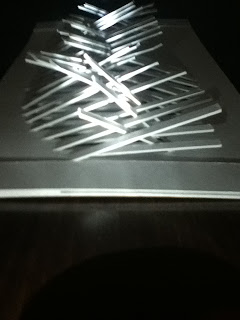It is my intention to create a pattern looking back to my Project 1 study of surfaces that appear to wear and disintegrate based on the number of points and divisions that I allocate the model.
svensson|arch670|UMD
Sunday, May 13, 2012
...on Generative Components
It is my intention to create a pattern looking back to my Project 1 study of surfaces that appear to wear and disintegrate based on the number of points and divisions that I allocate the model.
...on Recombinant sequence models
So here is the final model. The two halves have been woven together. You can now see how the different curves that made up the initial cuts, now influence the shape and curves seen in the model. Each piece can then be moved and manipulated to create a different curve and relationship, similar to that seen in the animation and previous model. In this version of the model the halves are fixed in place. However the construction of the model allows for the halves to be removed and interchanged to create different conditions and relationships.
Playing with the model pieces and lighting gave many different interpretations to the layers that made up the overall model.
Playing with the model pieces and lighting gave many different interpretations to the layers that made up the overall model.
...on Project 2 Prototypes
In attempting to create a physical model based on the previous maya models, I found that to create the overlap and weaving as seen in the renderings, the physical model itself would have to be woven. The images here show the halves that would be connected. They are both cut from the same sheet of strathmore board, and are inverse to each other. This occurs based on the curves that define the shape.
Once cut, every other strip is raised to create the opening needed to begin weaving the model.
Once cut, every other strip is raised to create the opening needed to begin weaving the model.
Sunday, April 8, 2012
Saturday, April 7, 2012
...on Recombinant Sequences cont.
This analysis of the animation looks to discover in depth the movement of planes and the relationships of the movements over time.
...on Recombinant Sequences: Model 1

 This first model attempt looks at creating a surface from the movements seen in the previous animations. The overall interpretation of the animation focuses on the movements of the camera and the objects, but also on the focus of framing, transparency, and negative space. Breaking down the orientation of the model: in one direction the movement of the camera and the obects are modeled creating curves. The second direction follows the movement and interaction between the camera and the modeled objects.
This first model attempt looks at creating a surface from the movements seen in the previous animations. The overall interpretation of the animation focuses on the movements of the camera and the objects, but also on the focus of framing, transparency, and negative space. Breaking down the orientation of the model: in one direction the movement of the camera and the obects are modeled creating curves. The second direction follows the movement and interaction between the camera and the modeled objects.  While this model is in part successful in communicating the movement, I believe that the model could become more ambiguous in its interpretation by moving away from such a structured and rigid framework. Looking back to the animation there is an ambiguity and vagueness to the movement and overal frame and motion. This is due in part to the amount of negative space allowing for a focus on the objects and what is revealed through motion and lighting in what seems a void.
While this model is in part successful in communicating the movement, I believe that the model could become more ambiguous in its interpretation by moving away from such a structured and rigid framework. Looking back to the animation there is an ambiguity and vagueness to the movement and overal frame and motion. This is due in part to the amount of negative space allowing for a focus on the objects and what is revealed through motion and lighting in what seems a void.Saturday, March 31, 2012
...on Spatial and Temporal Sequences Revisted cont.
Further layering the animation re-interprets the directors choice of framing and movement as seen in the clip "Money" from Cabaret. By layering and offsetting the animations a ghosting effect occurs, allowing for an understanding of time and the sequences of moves.
Subscribe to:
Posts (Atom)












